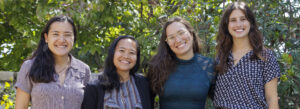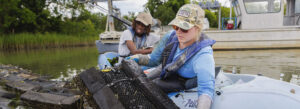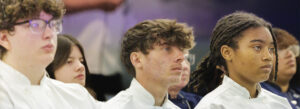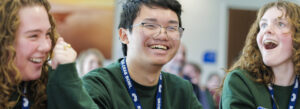‘Teachers on the Estuary’ Workshop equips educators with hands-on coastal knowledge
“Hermit crab, or snail?” Asked a teacher, peering into the muck of a mud flat near Wachapreague, Virginia. With one hand, she picked through the dirt outlined by a grid, and in the other hand, she held a laminated guide with pictures of some of the critters residing in the mudflat.
She worked with another teacher to tally up the worms and snails within the square foot marked by a quadrant—in this case, a square of PVC pipe—to sample the organisms living along different sections of the mud flat.
These were two of 16 teachers—mainly from high school and middle school science classrooms—who had a chance to learn about estuarine habitats during a four-day workshop in June. The annual workshop was hosted by educators from the Chesapeake Bay National Estuarine Research Reserve (CBNERR) and the VIMS Marine Advisory Program (VIMS MAP).
Each year, teachers at the workshop have a chance to explore seaside habitats like the barrier islands and mud flats, as well as bayside habitats like eelgrass beds and marshes.
“It’s not often that teachers have a chance to explore these habitats firsthand, especially for teachers inland and far away from the coast,” said Lisa Ayers Lawrence, marine education program leader for VIMS MAP. Although each year’s workshop is a little bit different, the teachers always leave with resources—both pre-made lesson plans and firsthand knowledge of coastal habitats. They also practice taking water quality measurements in different waterbodies. After wading through shallow water with a seining net, the teachers learned about pufferfish, blue crabs, and needlefish they caught.
“Learning all the techniques for teachers with other teachers gave me the confidence to have my students out in the field,” said Kathleen Harrison, a science teacher at Hampton High School who has attended previous workshops. “And I loved being out on the water.”
Harrison incorporated the techniques and knowledge from the workshop into field trips to the Eastern Shore for the students in her International Baccalaureate biology class. She said she’s also able to incorporate that knowledge into the classroom by discussing how human activities nearby affect the health of the water.
“If we’re talking about fishing in China, that doesn’t mean as much as the blue crab industry that’s close to home,” Harrison said.
The annual workshop was hosted by educators from the Chesapeake Bay National Estuarine Research Reserve (CBNERR) and the VIMS Marine Advisory Program (VIMS MAP).
But for teachers who can’t bring their students to the coast, workshop instructors also offered ways to incorporate fieldwork techniques like transects and plant identification in a nearby meadow or graveyard, which often have old or unusual plants.
“You can have students identify plants based on their adaptations, or have students make up names for the plants that mean something to the students,” said Dick Snyder, director of the VIMS Eastern Shore Lab, who lead the boat trips during the workshop.
Snyder and other scientists shared their firsthand knowledge of these habitats with the teachers during the mornings spent out in the field. In the afternoons, workshop participants graphed the data points they collected earlier that day and discussed resources and lesson plans. The hours from the four-day field course counted toward teachers’ the professional development time requirements for recertification.
“Oftentimes, that means attending a conference or sitting in a classroom,” said Adrienne Rylander, who teaches science at Menchville High School. “This is so much better.”
Takeaways:
- The four-day field course gives educators a chance to hear from coastal scientists and try their hand at data-gathering techniques.
- This year, education specialists from Chesapeake Bay National Estuarine Research Reserve and the VIMS Marine Advisory Program teamed up to bring 16 teachers to the VIMS Eastern Shore Lab.
- The workshop allows teachers farther away from the coast to bring coastal science back to their classrooms.
Photos and video by Aileen Devlin | Virginia Sea Grant
Story by Madeleine Jepsen | Virginia Sea Grant
Published Aug. 17, 2021.
“Learning all the techniques for teachers with other teachers gave me the confidence to have my students out in the field,” said Kathleen Harrison.





